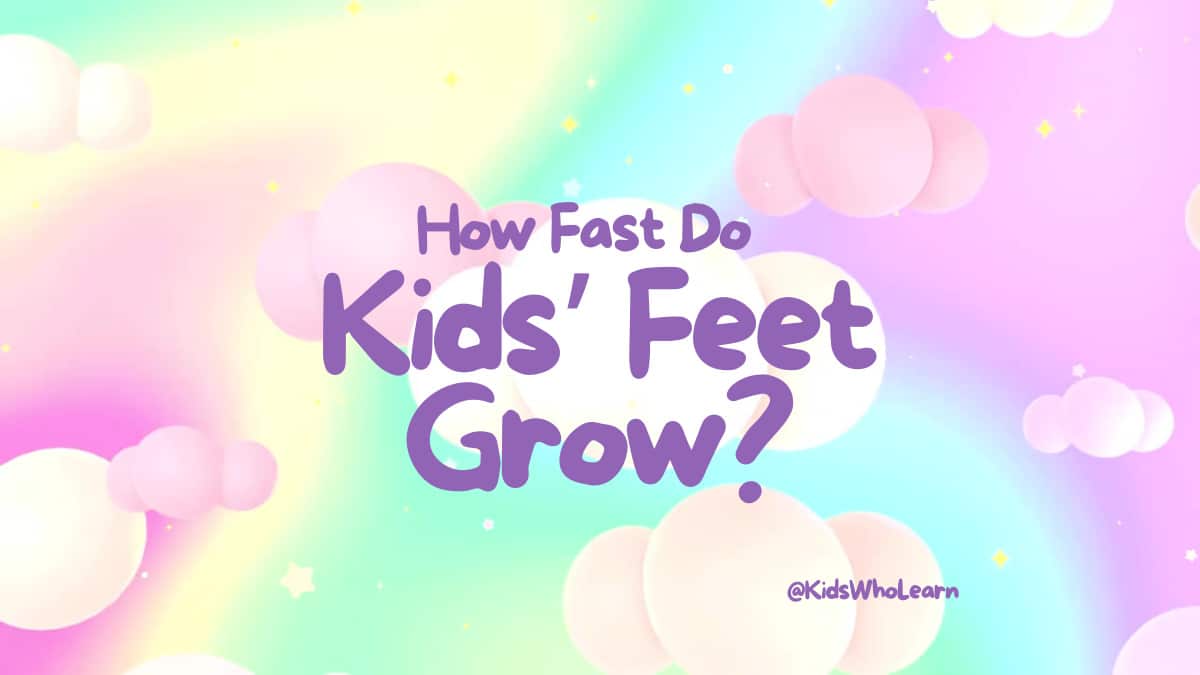Kids grow up so fast, and it’s not just their height that changes. Parents often wonder how fast their kids’ feet grow and how to keep up with their shoe size. Understanding kids’ feet growth is important to ensure they have proper support and comfort, as well as to prevent foot problems in the future.
The growth rate of kids’ feet varies depending on their age and gender. Babies’ feet grow rapidly during their first year, with an average of one size every two to three months. How fast do toddlers’ feet grow? Toddlers’ feet grow at a slower rate, with an average of one size every four months. Boys’ feet tend to grow faster than girls’, and they usually reach their maximum foot size by age 16, while girls’ feet stop growing around age 13. Knowing these growth patterns can help parents anticipate when their kids will need new shoes and how often to measure their feet.
Key Takeaways
- Kids’ feet grow at different rates depending on their age and gender.
- Parents should measure their kids’ feet regularly to ensure they have the right shoe size.
- Choosing the right shoe size and maintaining foot health are important for kids’ comfort and development.
Understanding Kids’ Feet Growth
How much do kids’ feet grow? Kids’ feet grow rapidly during their early years, and understanding the growth patterns and factors affecting the growth rate can help parents choose the right shoes for their children.
Growth Patterns
The growth of kids’ feet can be divided into two phases: the baby phase and the childhood phase. During the baby phase, which lasts until about 12 months, the feet grow rapidly, increasing in size by about half a shoe size every two months. During the childhood phase, which lasts until the age of 18, the growth rate slows down to about half a shoe size per year.
It’s important to note that the growth rate can vary from child to child and may be affected by factors such as genetics, nutrition, and physical activity.
Factors Affecting Growth Rate
Several factors can affect the growth rate of kids’ feet. Here are some of the most important ones:
- Genetics: The size and shape of kids’ feet are largely determined by their parents’ genes. If one or both parents have large feet, it’s likely that their children will have large feet as well. Similarly, if both parents have little feet, it is also likely their children will have little feet.
- Nutrition: Adequate nutrition is essential for healthy growth, including the growth of kids’ feet. A balanced diet that includes plenty of protein, vitamins, and minerals can help ensure that kids’ feet grow properly.
- Physical activity: Regular physical activity can help promote healthy foot development by strengthening the muscles and bones in the feet. However, excessive physical activity or wearing ill-fitting shoes can lead to foot problems such as blisters, calluses, and ingrown toenails.
- Shoes: Wearing shoes that fit properly and provide adequate support is crucial for healthy foot development. Ill-fitting shoes can cause a range of foot problems, including blisters, calluses, and bunions. It’s important to choose shoes that are the right size and shape for your child’s feet and that provide adequate support for their activities.
By understanding the growth patterns and factors affecting the growth rate of kids’ feet, parents can make informed decisions about their children’s footwear and help ensure that their feet grow healthy and strong.
How Fast Do Kids’ Feet Grow?
Kids’ feet grow rapidly during their early years. From birth to age 3, their feet can grow up to a half size every two to three months. By age 5, their feet will have reached about half their adult size.
During puberty, kids’ feet can grow rapidly, with some experiencing growth spurts of up to two shoe sizes in just one year. Girls’ feet typically stop growing between the ages of 14 and 15, while boys’ feet may continue to grow until they are 16 to 17 years old.
Factors that can affect the rate of growth include genetics, nutrition, and physical activity. Children who are more active may have larger feet due to the development of muscles and bones in the feet and legs.
It is important to ensure that children are wearing properly fitting shoes to support their growing feet. Ill-fitting shoes can lead to foot problems such as blisters, calluses, and ingrown toenails. Parents should regularly measure their child’s feet and replace shoes as needed to accommodate growth.
In summary, kids’ feet grow rapidly during their early years and can experience growth spurts during puberty. Properly fitting shoes are important to support their growing feet and prevent foot problems.
Signs of Outgrown Shoes
As children grow, their feet grow too. It’s important to keep an eye on the size of their shoes, as wearing shoes that are too small can cause discomfort and even lead to foot problems. This may mean that kids may need to size up a full or half a size throughout their developmental years. Here are some signs that your child may have outgrown their shoes:
- Tightness: If your child’s shoes are feeling tight, it’s a sign that their feet have grown and the shoes are no longer a good fit. You may notice that your child is complaining of discomfort or that their toes are cramped at the end of the shoe.
- Toe Creasing: Another sign that your child has outgrown their shoes is if there is excessive creasing at the toes. This can indicate that the shoe is too short and is not providing enough room for your child’s toes to move freely.
- Worn Soles: If the soles of your child’s shoes are worn down, it’s a sign that they have been wearing the shoes for too long and may have outgrown them. Worn soles can also be a safety hazard, as they can cause slips and falls.
- Redness or Blisters: If your child is experiencing redness or blisters on their feet after wearing their shoes, it’s a sign that the shoes are too small and are causing friction on their skin.
It’s important to regularly check your child’s shoe size and look out for these signs of outgrown shoes. It’s recommended that you measure your child’s feet every six months to ensure that they are wearing the correct shoe size. A good rule of thumb is to make sure there is about a thumb’s width of space between the end of the shoe and your child’s longest toe.
Choosing the Right Shoe Size for Kids
When it comes to buying shoes for kids, it’s important to choose the right size to ensure comfort and proper foot development. In this section, we’ll discuss how to measure kids’ feet and understand shoe sizes.
Measuring Kids’ Feet
Measuring kids’ feet is a crucial step in finding the right shoe size. Here are some tips to help you measure your child’s feet accurately:
- Measure both feet: Kids’ feet can vary in size, so it’s important to measure both feet to ensure the shoes fit comfortably.
- Measure at the end of the day: Feet tend to swell throughout the day, so it’s best to measure at the end of the day when the feet are at their largest.
- Use a ruler or measuring tape: Place the ruler or measuring tape on a flat surface and have your child stand on it with their heel against the wall. Measure from the wall to the longest toe and use this measurement to determine shoe size.
Understanding Shoe Sizes
Shoe sizes can be confusing, especially when it comes to kids’ shoes. Here are some things to keep in mind:
- Shoe sizes vary by brand: Different shoe brands may have slightly different sizing, so it’s important to measure your child’s feet and check the brand’s size chart before purchasing.
- Leave room for growth: Kids’ feet grow quickly, so it’s important to leave some room for growth when choosing shoe size. A general rule of thumb is to leave about half an inch of space between the longest toe and the end of the shoe.
- Consider the shoe’s width: Kids’ feet vary in width as well, so it’s important to choose a shoe that fits comfortably in both length and width.
By following these tips, you can choose the right shoe size for your child and ensure their comfort and proper foot development.
Maintaining Foot Health in Growing Kids
As kids grow, their feet grow too. It is important to ensure that their feet are healthy and comfortable as they develop. Here are some tips for maintaining foot health in growing kids:
Foot Care Tips
- Keep toenails trimmed straight across and not too short to avoid ingrown toenails.
- Encourage kids to wear shoes that fit properly and are appropriate for the activity they are doing.
- Make sure socks are clean, dry, and fit well.
- Wash feet daily with soap and water, making sure to dry them thoroughly, especially between the toes.
- Apply moisturizer to keep feet soft and prevent cracking.
When to Consult a Podiatrist
Sometimes, despite best efforts, kids may experience foot problems. Here are some signs that it may be time to consult a podiatrist:
- Persistent foot pain or discomfort
- Changes in the way your child walks or stands
- Toenail or skin problems that do not improve with at-home care
- Flat feet or other foot deformities
Regular check-ups with a podiatrist can help ensure that your child’s feet are healthy and developing properly. By following these foot care tips and seeking professional care when necessary, you can help your growing child maintain healthy and happy feet.
Frequently Asked Questions
How quickly do children’s feet grow?
Children’s feet can grow rapidly during certain stages of development. The rate of growth can vary depending on the child’s age, gender, genetics, and other factors. It is common for infants and toddlers to experience significant growth spurts in their feet during the first few years of life.
What is the average rate of growth for a child’s feet?
On average, children’s feet grow about 1.5mm per month, or roughly half a shoe size per year. However, this rate of growth can vary significantly depending on the child’s age, gender, and other factors.
How often should I measure my child’s feet?
It is recommended that parents measure their child’s feet every three to four months to ensure that they are wearing shoes that fit properly. This is especially important during periods of rapid growth, such as during infancy and adolescence.
At what age do children’s feet stop growing?
Children’s feet typically stop growing by the age of 18, although some individuals may experience continued growth into their early 20s. It is important to note that the rate of growth can vary significantly depending on the individual.
Is there a growth chart for children’s feet?
Yes, there are growth charts available that can help parents track their child’s foot growth over time. These charts can be found online or obtained from a pediatrician or podiatrist.
Do children’s feet grow at a faster rate during certain ages?
Yes, children’s feet can grow at a faster rate during certain stages of development. Infants and toddlers may experience significant growth spurts in their feet during the first few years of life, while adolescents may experience another period of rapid growth during puberty.







